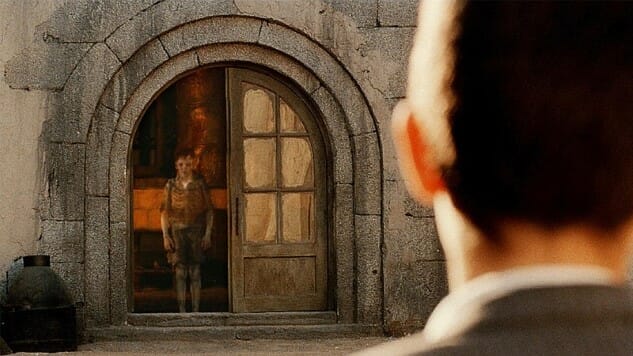This post is part of Paste’s Century of Terror project, a countdown of the 100 best horror films of the last 100 years, culminating on Halloween. You can see the full list in the master document, which will collect each year’s individual film entry as it is posted.
The Year
Not the deepest year, necessarily, but one with some very strong choices at the top of the list, and a legitimately difficult three- or four-way pick between the biggest contenders—especially between The Others and The Devil’s Backbone as they represent two different (but excellent) flavors of ghost story.
Ultimately, the pick is The Devil’s Backbone, if only because The Others feels so deeply indebted to The Innocents and the many other gothic ghost stories that had come before it. Not to diminish Alejandro Amenábar’s film, but it simply feels slightly more familiar, though often eerily beautiful. Nicole Kidman is excellent as an overprotective mother in WWII England who attempts to shield her light-sensitive children from what seems to be a malevolent force, disturbing the peace in their country manor. As the story unfolds, however, it inverts on itself like a ghostly Möbius strip, turning a straightforward haunted house story into something with more of a metaphysical flavor. Visually, it’s one of the decade’s best ghost stories for certain, with a classically spooky vibe that can be difficult to replicate in modern film. Certainly, The Others is a throwback in the best of ways.
The year’s other strongest contender is Frailty, a harrowing psychological horror film directed by and starring the late, great Bill Paxton in what was quietly one of the actor’s best roles. Here, he’s playing a father raising two young sons in 1979, when he receives an angelic vision instructing him to abduct and kill “demons” disguised as human beings. One son is convinced of the veracity of these visions, while the other suffers from a much more tenuous grasp on his faith, doubting the sanity of his father and unsure of how to proceed. Like the best thrillers, the truth is always kept out of grasp until the film’s conclusion, but the tug of war between faith, family loyalty and the suspicion of mental illness makes for powerful drama, with Paxton feverishly commanding the screen and Matthew McConaughey turning in a solid performance, years before the supposed beginning of the “McConaissance.”
The rest of the 2001 lineup includes an array of titles, from the well-regarded, minimalist indie psych-horror of Session 9 to the decidedly lesser, big-budget Hollywood sequel of Hannibal, or the hyper-violent Japanese weirdness of Ichi the Killer. All in all, a solid year as the horror genre revs to life following the 1990s.
2001 Honorable Mentions: The Others, Frailty, Session 9, Ichi the Killer, Hannibal, Pulse, From Hell, The Happiness of the Katakuris, Jeepers Creepers
The Film: The Devil’s Backbone
Director: Guillermo del Toro
The precise moment in which The Devil’s Backbone takes place is utterly instrumental to the telling of Guillermo del Toro’s Spanish ghost story. A year and date aren’t given, but they can be roughly surmised from the psychological state of the characters on screen. It’s the final days of the Spanish Civil War, and for those who backed the democratically elected republic, it’s clear that the writing is on the wall. That impending sense of doom—the utter certainty that despite fighting the good fight, oppression is right around the corner—colors the film with a palpable sense of apocalyptic dread, and an uncertainty as to what will be left when it’s all over. Those who fought for their democracy aren’t about to give up, but their faces bear the crushing grief of defeat—they’re just going through the motions at this point.
And suffice to say, children growing up in a dingy little orphanage deserve better than caretakers who are just “going through the motions,” but they’ll have to take what they can get. Little Carlos arrives at the parched orphanage, the son of a man who died fighting in the hopeless conflict, without anyone he can call his own. Although he improbably forges a tenuous friendship with a local bully, perhaps its his utter aloneness that makes him receptive to visions from the beyond. Perhaps he’s been chosen specifically for this task; this commune with the dead. Perhaps that’s why the ghost of little Santi chooses to appear before him.
The Devil’s Backbone is both mystery and classic gothic ghost story, intertwining the adult drama of the orphanage’s caretakers, who are also funneling support to the doomed Republican fighters, and the trials of young Carlos, who is delving deep into the history of the orphanage itself, and unearthing some old skeletons in the process. The structure has obvious thematic similarities with del Toro’s own Pan’s Labyrinth, but where Pan is fantastical and beautiful, The Devil’s Backbone is grittier and more genuinely frightening. Like all of del Toro’s films, however, it maintains a deeply human emotional core, empathizing with the plight of its protagonists young and old, in a time when no one else could reasonably have done any better.
This is the kind of film that, like The Innocents or The Others, ages well thanks to the strength of its performances and its overall focus on instilling a specific mood over hammering home the scare chords or soon-to-be-outdated CGI. It manages to balance a tender portrayal of coming of age and making friends in an inherently hostile environment with classically creepy overtones, displaying symbolism that is both easy for an audience to grasp and satisfying for viewers to consider in greater depth. Tidy, self-assured and expertly constructed within the framework of a small budget, it was the film that proved the eventual Best Director winner was ready for bigger and more ambitious projects.
Jim Vorel is a Paste staff writer and resident horror guru. You can follow him on Twitter for more film and TV writing.
